Scientific name : Xylocopa violacea
Violet Carpenter Bees are big, beautiful and completely harmless to us – they may look a little intimidating, but they don’t sting. On first impressions the bees may appear to be completely black in colour, but when the sunlight catches their wings, a beautiful purple-blue sheen is reflected there, hence their scientific name of ‘violacea‘.
Behaviour:
The bees visit flowering plants and shrubs throughout the spring and summer, but may be seen on the wing as early in February or even January where flowers are present. On cooler days in the early spring they often ‘sunbathe’ on the warm trunks of trees, wooden fence posts and the like. The bees are very efficient pollinators of open flowers but as with several species of bumblebees, they can also ‘cheat’ and steal nectar from long tubular flowers, using their their size and weight to break into them from above, taking the sweet reward without collecting and distributing any pollen.
Despite their size the bees are not aggressive and their mission in life is simply to collect nectar and pollen from flowers. The male does not have the ability to sting, and as is the case with most species of bee, the female will only sting as a means of self-defence. The males pursue females that they wish to mate with and at that time will also chase off other males that may be in competition.
The name ‘carpenter bee’ is due to their tunnelling into dead wood in order to lay their eggs; the female uses her mandibles to chew into the wood, creating tunnels into which she will lay up to 15 eggs. Each egg will be provided with pollen on which to eat when it hatches. In a natural habitat they will often choose a fallen tree trunk or a standing tree that has parts beginning to soften with decay.
But they’re happy to utilise the facilities we provide too – a friend had one queen that tunnelled into a wooden door on an outhouse and did quite a bit of damage, although being an old door it may well have been starting to decay beneath the paint, giving her easy access. I’ve also watched one take over much of the bamboo-tube accommodation provided by a bee-hotel. It was fascinating to watch her squeeze herself in to the seemingly much-too-narrow tube.





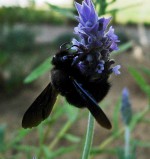
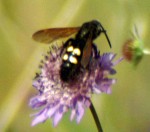
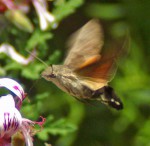

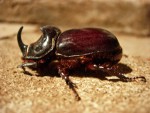
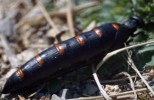
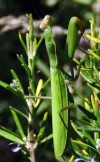

I have seen one of those on Verbena flowers here. What an interesting write up about this creature.
LikeLike
You can probably tell I love these big beautiful bumbling insects!
LikeLiked by 1 person
Yes, and it is no wonder you do, they are amazing! 🙂
LikeLiked by 1 person
Fascinating, thank you! We have seen a few of these in and near our holiday villa outside Gaucin – my son has a slightly horrified fascination with them and id’d them for us. We saw one yesterday at a painfully hip beach bar near Tarifa, disappearing into a hole in a wooden beam above our heads. I actually stumbled across your great blog today after driving past the San Roque storks a few times and heading online to find out more. Lots to read in the 2 days we have left here!
LikeLiked by 1 person
Thank you for taking the time to comment. I hope you enjoyed your time up in lovely Gaucin and down in Tarifa – it’s such a shame it’s become more hip & trendy over the last few years, but always did prefer it out of season! I can understand why these big beauties make some folks a little wary – my daughter thought I’d called them ‘Violent’ Carpenter Bees when she was younger! Best wishes
LikeLike
We are chuffed to have one/two living in our garden. She originally made a hole in two old beams and now seem to be in an old wind chime made of bamboo. I am delighted to have this beautiful creature in our garden and have managed to capture some lovely shots. We reside in Spain.
LikeLike
Happy to hear you’re enjoying sharing your space with these beautiful insects.
LikeLike
Living in Colmenar in the Andalusian mountains we get lots of insects. I saw one of these bees fly into our garage yesterday. Clearly happy in our pile of fire wood for the winter. Often see her flying in and out. Beautiful colour but I hate any flying insects so il just stay out of her way
LikeLike
Lucky you, I know that area quite well as have friends there and in Gaucin. Great area for Orchids too! Glad to hear you’re leaving the beautiful bee too it – hope her ‘nests’ are successful. Perhaps try to locate them and avoid burning them this coming winter! Look out for Mammoth Wasps now too – equally impressive and also harmless!
LikeLike
We have just seen our first Carpenter bee here in South Moravia in Czech Republic 🇨🇿
LikeLiked by 1 person
They’re pretty awesome in real life aren’t they?
LikeLike